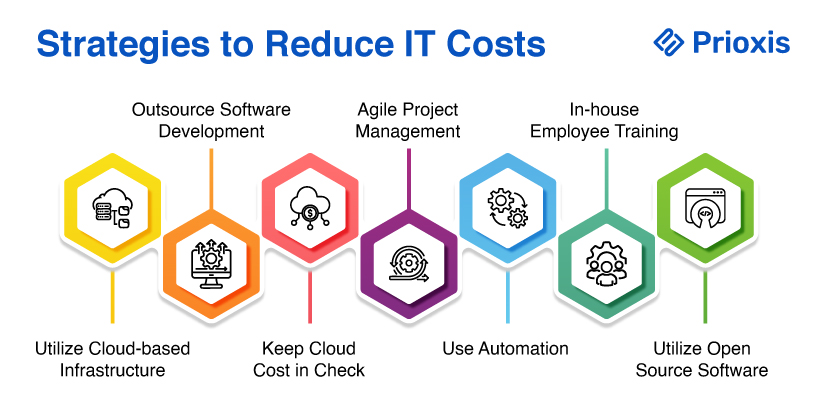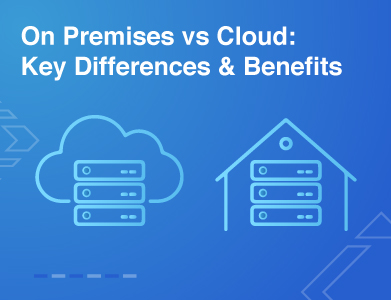Expertise
Staying ahead of innovation while keeping costs in check is challenging for companies in the digital age. IT costs can add up fast, and it's crucial to identify better ways to make the most of spending without sacrificing performance. Effective IT cost reduction—commonly known as IT cost optimization—isn't merely about cutting costs. It's about removing inefficiencies, getting the most out of resources, and achieving long-term financial security.
Nonetheless, decreasing IT costs necessitates planning. The slow slashing of prices may result in inefficiencies of systems, a dip in productivity, and security breaches. Such is why firms have to embark on strategic cost-reduction techniques with well-intentioned mechanisms for increasing efficiency while sustaining efficiency.
Explore 7 practical IT cost-cutting solutions for optimizing spending, increasing efficiency, and maximizing savings without sacrificing performance. Learn how to decrease IT costs wisely!
What is IT Cost Reduction?
IT cost reduction (or IT Cost Optimization) involves eliminating all inefficiencies of an IT department; such changes should not somehow affect operational effectiveness. The changes are not haphazard but strategic budget reductions in areas where savings can be realized without compromising essential core functions.
There are several methods for IT cost optimization: Infrastructure and process refinement; process stream alignment; automating repetitive tasks, etc. Each has a specific purpose, but in the end, the goal of all of them boils down to greater efficiency without sacrificing high performance.
They need proper planning cuts for cost. Drastic cost cuts might end up harming productivity, employee morale, and the overall business health scenario. On the other hand, a well-planned, efficiently executed cost optimization strategy can lead to better financial stability, improved agility, and a solid competitive edge in an increasingly volatile market.
Strategies to Reduce IT Costs
Cutting IT expenses while being efficient and innovative is a matter of concern for most companies. By implementing clever strategies, companies can maximize their IT budgets without compromising on quality. Here are some key methods to minimize IT costs without jeopardizing operational efficiency.

1. Outsource Software Development to Save IT Costs
Software development outsourcing is an economical method of developing and sustaining software programs without the burden of an in-house full-time team. Employing and training developers, paying salaries, and offering infrastructure to internal teams can be costly. With a trusted third-party vendor, companies can:
- Leverage a worldwide talent pool at competitive prices.
- Save on recruitment, training, and employee benefits expenses.
- Scale development up or down according to project requirements.
- Direct internal resources toward core business processes instead of software development.
Nearshoring and offshoring are two trendy outsourcing models that enable companies to choose providers from regions depending on the budget and the desired quality.
2. Utilize Cloud-based Infrastructure
The physical infrastructure setup requires massive capital investments in the hardware, software, maintenance, and IT staff personnel. In contrast, the flexible, scalable, and cost-effective nature of cloud computing allows businesses to:
- Pay for what they use (pay-as-you-go model).
- Reduce IT Costs on servers and networking hardware.
- Scale up or down, depending on changing demands.
- Receive automatic updates, security patches, and managed IT services.
Solutions, i.e., public, private, or hybrid clouds, fit different business requirements, allowing companies to choose the most economically viable model based on their needs.
3. Keep Cloud Cost in Check
Since embracing the cloud reduces hardware costs, badly managed cloud resources can lead to heavy operational costs. Companies must strive to keep costs under control by:
- Deploying cost monitoring and management tools for the cloud, such as AWS Cost Explorer or Azure Cost Management.
- Regularly reviewing and removing unused or underutilized resources.
- Optimizing cloud pricing using reserved instances, spot instances or hybrid pricing.
- Using automation to shut down specific cloud resources during off-peak hours.
Such proactive management will minimize the chances of any unwanted spending while maximizing ROIs.
4: Implement Agile Project Management
An agile project development methodology seeks to increase efficiency and lower IT costs, primarily through emphasizing iterative development, collaboration, and flexibility. Agile frameworks such as Scrum and Kanban allow companies to:
- Deliver their projects in small and manageable sizes to avoid rework and any imminent delays.
- Increase productivity in teams by allowing quick reactions to changes.
- Minimize risk from budget overruns due to correct resource utilization.
- Improve stakeholder interaction by allowing continuous feedback and collaboration.
These Agile methodologies enhance project execution within IT, reduce waste, and make it possible for timely completion within budget.
5. Use Automation
Automation can Reduce IT Costs or eliminate repetitiveness and in doing so decrease labor costs, human error, and increase efficiency. Automation can be applied in many sectors including;
- Software Development: Automation of testing, deployment, and monitoring of code minimizes manual work and speeds the overall development cycles.
- IT Security: Automated threat detection and response capabilities minimize risks and operational downtime.
- Customer Support: AI-supported chatbots and automated ticketing systems reduce reliance on large customer support teams.
- Data Management: Automated processes for data entry, backup, and reporting enhance the accuracy and speed with which data is processed.
Integrating automation tools and practices can help minimize operational costs and optimize productivity for the business.
6. Invest in In-house Employee Training
Hiring external consultants for IT jobs is an expensive undertaking in the long run. By continually training employees, a business can:
- Upgrade the team with the latest technical skills and industry knowledge.
- Reduce any reliance on third-party vendors.
- Enhance retention and job satisfaction among employees.
- Even ensure that it works with a team that can troubleshoot and resolve issues without external help.
Online training courses, certification programs, and internal workshops keep employees abreast of emerging technologies and best practices.
7. Utilize Open Source Software
Proprietary software licenses are often expensive. Solutions abound in open-source, where quality is still possible to mitigate the cost. Usage examples would be companies using open-source software for the following.
- Development: Python, Node.js, React-all excellent tools in developing software that cut cost down.
- Security: Quality Protection using Snort and OpenVAS, both open-source security solutions.
- Data Management: The cost-effective open-source databases PostgreSQL and MySQL compared to proprietary systems.
- Office Productivity: LibreOffice: OpenOffice provides free solutions in comparison to commercial productivity suites.
Thus, the incorporation of open-source solutions enables organizations to save huge amounts from software acquisition costs and, at the same time, enjoy community-driven support and future improvements.
Conclusion
By applying these IT Cost Reduction Strategies, companies can counter economic challenges and still preserve efficiency and innovation. Whether cloud costs are optimized, automation is employed, or software development is made more streamlined, each solution accounts for great IT Cost-Saving Strategies and increased performance.
The secret to achieving maximum cost-effectiveness is embracing a customized blend of these strategies that complement particular business objectives. Periodic evaluation of IT infrastructure, recognition of areas that need improvement, and strategic adjustments will guarantee long-term viability.
Even modest, thoughtful investments in such cost-cutting initiatives can leave resources available for future innovation and expansion. Adopting these clever IT cost-cutting strategies can reinforce the competitive strength of a company and ensure long-term prosperity.











